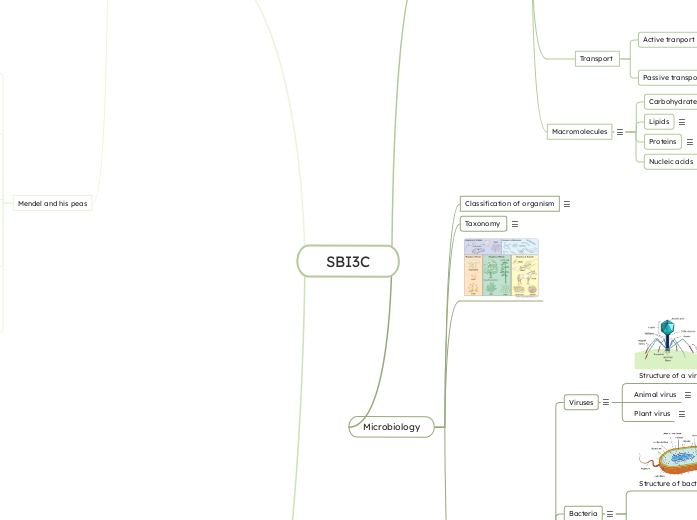door Sofia Pinto 1 jaar geleden
141
SBI3C

door Sofia Pinto 1 jaar geleden
141

Meer zoals dit
Pedigree charts show a record of the family
of an individual
They can be used to study the transmission
of a hereditary condition
They are particularly useful when there are
large families and a good family record over
several generations.
Sex-linked traits are traits that
are controlled by genes on the
sex chromosomes
The X and Y chromosomes
Each species has a specific number of
chromosomes
For example humans
total number of chromosomes is 46
diploid number is 46
2n = 46
the number of chromosomes in the
gametes is the haploid number or n =
23
Telophase I and II
Anaphase I and II
Metaphase I and II
Prophase I and II
Cytokinesis
the actual splitting of the
cytoplasm into two
separate cells is called
cytokinesis
occurs differently in
both plant and animal
cells
Animal cells: cleavage
furrow pinches cell
Plant cells: cell plate
forms in between
Telophase
the chromosomes, the cytoplasm and organelles
divide into 2 portions.
this diagram shows the end of telophase
Anaphase
the chromosomes split at the centromere
the ‘sister’ chromatids are pulled by the spindle
fibers to opposite poles of the cell.
Metaphase
spindle fibres attach to the chromosomes at the
centromere
chromosomes line up the middle of the cell
Prophase
the DNA recoils, and the chromosomes
condense
the nuclear membrane disappears
mitotic spindles begin to form
DNA is replicated
along with
organelles and
other cellular
components and
the cell prepares for
division.
To replace dead or dying cells
To allow an organism to grow and develope
Interphase
in between stages of dividing
G1—beginning cell growth
S—DNA duplicates (makes a copy)
DNA is in the form of chromatin
G2—cell undergoes it’s function
Prokaryotes
Eukaryotes
Eukaryotic & Multicellular
No cell walls
Internal heterotrophs
Fungi structure
Connection to human disease
Many mushrooms are highly toxic (produce neurotoxins)
Several disease caused by fungi, mostly annoying but
minor
Main functrions
Absoption of nutrients
Reproduction
Differences to plants
May have many nucleic per cell
Heterotrophs
Few/no storage molecules
Chitin in cell wall
Use spores not seeds to reproduce
Similarities to platns
Eukaryotic
Numerous organelles
Cell walls
Usually in soil
Reproduce asexually or sexually
Do not move around
Common feautures
Most are unicellular (one-celled)
Eukaryotic (have nucleus)
Reproduce sexually and asexually (binary fission)
Need moist environment
Three groups:
Animal-like
Protozoa
Amoebas
Plantlike
lakes (halophiles), environments without
oxygen (methanogens), extreme temperatures
(thermophiles)
All bacteria are:
Classification
By shape: Cocci (round) , Bacili (rod shaped), Spirili (spiral), Staphylo (clusters), Strepto (chains), Diplo (pairs) , Mono (individual cells)
By nutrition and respiration
Aerobic
(use oxygen to produce energy
from food) or anaerobic (do not require
oxygen to produce energy)
Heterotrophic
(must eat others for food)
or autotrophic (able to make own food)
Gram negative
Stained pink, these bacteria have a thin cell wall and many are pathogenic.
Gram positive
stained purple
after a dyeing technique
these bacteria have a thick cell
wall and are mostly harmless
Structure of bacteria
Plant virus
through a cell wall injury or when pollination occurs
Animal virus
triggers cell to engulf or ‘eat’ virus (endocytosis)
Structure of a virus
Science of naming.
Binomial nomenclature
Scientific name.
Kingdom
Phylum
Class
Order
Family
Genus
Spieces
a very large organic
molecule containing many carbon.
1. Carbohydrates (sugars)
2. Lipids (fats)
3. Proteins
4. Nucleic Acids (DNA & RNA)
Where organisms store information about the structures of
their proteins
- Polymers of nucleotides
Macronutrient that is essential for building muscle mass
Most diverse and important molecule in living organisms
Produced by protein synthesis
- A molecule made up of carbon, hydrogen, and oxygen
- Used by animals as energy storage molecules
- Soluble (dissolves) in oils and other non-polar solvents
- Insoluble (does not dissolve) in H2O
Molecules that contain carbon, hydrogen, and oxygen. Used mainly by living organisms for energy. Produced by plants by photosynthesis
Passive transport
There's three types.
Active tranport
an energy-driven process where membrane proteins transport molecules across cells, mainly classified as primary or secondary, based on how energy is coupled to fuel these mechanisms.
Bulk transport
Exocitosis
Endocytosis
Pynocytosis
Cell drinking
Phagocytosis
Cell eating
Pseudopods
Pseudopods – fingerlike projections sent out by
cell membrane that enclose particle
Main cellular functions
the formation of a peptide bond between the carboxyl group at the end of a growing polypeptide chain and a free amino group on an incoming amino acid.
organelles involved
Takes place in the lysosomes. It helps break down cellular waste products , broken cell organelles, bacteria.
Digestion of food
Lysosomes
Transfer or chemical energy (glucose) into ATP.
ATP is a high energy molecule that gives us usable energy.
Two types
Aerobic (with oxygen)
Anaerobic (without oxygen)
Mitochondria structure
Outer membrane: Protects the mitochondria
Inner membrane: Contains proteins that function to make atp.
Cristae: Infolded parts of inner membrane , increase the area available.
Matrix: Contains proteins and Mitochndria DNA.
Mitochondria
The basic unit of life.
Caractheristics of life.
Cell theory